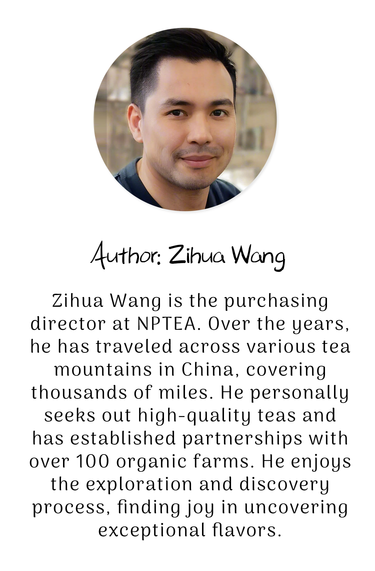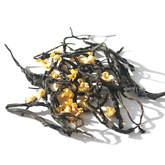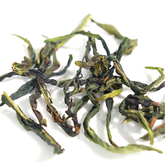Complete Guide to Types of Chinese Black Tea: Origins, Varieties, Brewing
When Westerners talk about black tea, they often think of the bold strength of Assam tea or the smooth richness of Ceylon black tea. However, few realize that the true birthplace of black tea is China.As early as 1568, tea farmers in the Wuyi Mountains of Fujian Province invented the world's first black tea—Lapsang Souchong. It traveled across oceans along the Maritime Silk Road, quietly reshaping the global history of tea.
Unlike the flavored black teas commonly found in the West, Chinese black tea (known as “hong cha” in China) is typically produced from a single origin. This gives each tea its own distinct aroma, taste, and tea liquor color, deeply influenced by its local terroir.
From Lapsang Souchong in Tongmu Village, Fujian, to Keemun black tea (Qimen) in Anhui, and Yunnan black tea (Dianhong) in Yunnan Province, every variety of Chinese black tea represents a specific region and a unique flavor profile.

In this article, we’ll take you through a complete guide to the types of Chinese black tea, exploring their origins, introducing signature teas from different regions, and sharing the best brewing methods for black tea. Whether you’re a beginner or a seasoned tea drinker, this guide will help you fully appreciate the depth and diversity of Chinese black teas.
The Relationship Between Red Tea and Black Tea
Simply put, Red Tea and Black Tea refer to the same tea, but the names are based on different perspectives. This interesting difference originated in the 17th century, when Chinese Red Tea was first introduced to Europe through maritime trade.
The Western Perspective: The Color of the Leaves
When British merchants first encountered this new tea in Fujian, they didn't see the brewed liquid. Instead, they saw the dried, tightly rolled leaves, which were a very dark, almost black color. For them, the color of the leaves was the most prominent feature, serving to distinguish it from green tea, which was already popular. Therefore, they named it Black Tea based on the appearance of the leaves.

The Chinese Perspective: The Color of the Brew
In China, the name 红茶 (Hóngchá), which translates to Red Tea, was born from its unique full-oxidation process. When this Red Tea is steeped in hot water, it produces a bright, warm, reddish-brown liquor. Chinese tradition has always named tea based on the color of the brewed liquid. Thus, this tea was naturally named Red Tea for its beautiful reddish liquor.
The Origins of Chinese Black Tea
The history of Chinese black tea can be traced back to the late Ming and early Qing dynasties, around the 17th century. It was the first type of Chinese tea to be exported overseas and is considered one of the most globally influential categories of Chinese tea. Among all Chinese black teas, the most iconic and historically significant is Lapsang Souchong, which originated from the Tongmu Village in the Wuyi Mountains of Fujian Province.

According to legend, during the late Ming Dynasty, tea farmers in the Tongmu region of Wuyi Mountain were delayed in processing their tea due to a military troop passing through the village. This interruption caused the freshly picked tea leaves—originally intended for green tea—to oxidize naturally in the warm and humid environment. Instead of spoiling, the leaves developed a unique aroma of pine smoke and dried longan sweetness.
In an effort to salvage the crop, the farmers used local pinewood (specifically Pinus massoniana) to smoke-dry the leaves. This accidental innovation resulted in the creation of the world’s first black tea—Lapsang Souchong, also known as smoked black tea.
This unexpected breakthrough in tea processing not only gave birth to a new style of tea but also laid the foundation for what we now recognize globally as black tea.
The Trade and Spread of Chinese Black Tea Craftsmanship
Starting in the 17th century, with the opening of the Maritime Silk Road, Chinese tea, especially black tea, began to be exported in large quantities. Among them, Lapsang Souchong, the most representative type of Chinese black tea, was the first to be accepted by European markets. The British especially loved its rich, full-bodied flavor and long shelf life. By the late 18th century, black tea had quickly become popular in the UK, becoming a daily beverage among both the nobility and the rising middle class. More importantly, black tea gradually became the center of British afternoon tea culture, driving a nationwide shift in tea-drinking habits.
Meanwhile, black tea also became highly popular in Russia. In the 19th century, through the “Tea Road” (also known as the Sino-Russian Tea Horse Road), Chinese black tea was transported by camel caravans all the way to Moscow and St. Petersburg, becoming a staple in aristocratic social circles. Russians developed a tradition of drinking Chinese black tea with sugar and lemon, a custom that remains an important part of Russian tea culture today.
Starting in the mid-19th century, due to China’s monopoly on tea and the rising costs, Western countries began experimenting with growing tea themselves, especially in India and Ceylon (now Sri Lanka). The British not only brought Chinese tea tree varieties to their colonies, but also recruited large numbers of Chinese tea artisans to teach planting and processing techniques. The traditional Chinese black tea craftsmanship—especially the key steps of rolling (揉捻) and fermentation—were gradually adopted and localized, eventually giving rise to globally recognized black tea varieties like Assam black tea and Ceylon black tea.
Types and Characteristics of Chinese Black Tea
Chinese black tea can generally be divided into five core production regions: Fujian, Yunnan, Anhui, Hubei, and Sichuan. Each region has its own unique geographical features, climate, and tea-making techniques, giving rise to distinct and representative types of Chinese black tea. Overall, Chinese black teas are known for their rich aromas, smooth and full-bodied taste, and bright red liquor. These premium-quality loose leaf black teas are ideal for drinking on their own—there’s no need to add milk or sugar, as they are naturally smooth without bitterness.
China's tea-growing regions span a vast area, and the variety of black teas is extensive. Below are introductions to some of the most iconic Chinese black teas:
Lapsang Souchong
Origin: Tongmu Village, Wuyi Mountains, Fujian Province
Flavor Profile: Known for its natural pine smoke aroma and sweet honey fragrance, the tea liquor is a bright reddish hue with a smooth, slightly sweet taste. It carries a distinctive wild mountain character. Traditional versions have a smoky flavor, while modern styles lean more toward floral and fruity notes. This is considered the world’s first black teaand a must-try for those exploring the origins of black tea.

Jin Jun Mei
Origin: Tongmuguan, Wuyi Mountains, Fujian
Flavor Profile: Made exclusively from spring tea buds, this high-end black tea features an intense floral-honey aroma and a refined, sweet, and lasting flavor. The tea soup is full-bodied and lingers on the palate, making it one of the most premium Chinese black teas available.
Dian Hong
Origin: Lincang, Fengqing, and other regions in Yunnan Province
Flavor Profile: This tea is famous for its bold honey and fruity aroma, bright red liquor, and strong, sweet taste. The more golden tips (buds) it contains, the better the quality. Dian Hong is one of the most popular Chinese black teas in the international market and a top choice among black tea lovers worldwide.
Keemun Black Tea
Origin: Qimen County, Anhui Province
Flavor Profile: Known for its signature "Keemun aroma", which blends fruity, floral, and a touch of light smoky notes. The tea liquor is a vivid red with a fresh, mellow sweetness. It has long been a key ingredient in traditional British-style black tea blends.

Yihong Gongfu Tea
Origin: Yichang, Enshi, and surrounding areas in Hubei Province
Flavor Profile: This tea offers a sweet and clean aroma, often with honey or fruity notes. The liquor is bright red and the taste is mellow and soft, making it ideal for daily consumption. In the 19th century, it was one of the most widely exported Chinese black teas, playing a vital role in China’s historical tea trade.
Chuanhong Gongfu Tea
Origin: Yibin and other areas in Sichuan Province
Flavor Profile: Characterized by rich fragrance, bright red liquor, and a smooth, sweet aftertaste. It combines floral and sweet aromas with caramel and woody notes, offering a well-layered tasting experience. A distinctive yet lesser-known Chinese black tea variety worthy of international attention.
How to Properly Brew Chinese Black Tea
When brewing Chinese loose leaf black tea, there are several key factors to consider: teaware, tea-to-water ratio, water temperature, and steeping time.
It is recommended to use a gaiwan (lidded bowl) when brewing Chinese black tea. The gaiwan allows for quick separation of tea leaves and water, helping to avoid over-steeping. This method is especially suitable for delicate teas like Keemun black tea and Lapsang Souchong. A proper tea-to-water ratio is 1:30, which means using 5 grams of tea leaves for every 150ml of hot water.

Because Chinese black tea leaves are twisted and rolled during processing, they release compounds more easily. If brewed with boiling water (100°C), it may cause excessive bitterness. Therefore, the recommended water temperatureis around 85°C (185°F) for a smoother and sweeter infusion.
Each steep should be kept short—between 5 to 10 seconds initially. With each subsequent infusion, you can increase the steeping time by 5 seconds. This technique helps to fully bring out the aroma, flavor layers, and natural sweetness of high-quality Chinese black teas.
| Factor | Parameters/Method | Key Notes | Tips |
|---|---|---|---|
| Teaware | Gaiwan (Chinese lidded bowl) | Quick water-tea separation prevents bitterness | Avoid Yixing clay teapots (absorbs aroma) |
| Tea-to-Water Ratio | 1:30 (5g tea + 150ml water) | Balanced strength and flavor longevity | Use a measuring cup or digital scale (±0.5g error) |
| Water Temperature | 85°C (~185°F) | Gentle heat avoids releasing harsh tannins | Let boiled water cool for 2 minutes or mix with 10% cold water |
| Steeping Time | 1st steep: 5-10 sec; +5 sec per steep | Gradual flavor release for layered aroma | Large-leaf varieties (e.g., Dian Hong/Yunnan Black Tea): Start with 3 seconds |
How to Store Black Tea Properly
The key to storing black tea lies in keeping it dry, moisture-proof, sealed, and away from direct light. Although black tea is fully fermented and doesn't spoil as quickly as green tea, exposure to moisture, air, or sunlight can cause the leaves to absorb moisture and oxidize. This leads to the loss of aroma, a weakened flavor, or even unpleasant tastes.(Further Reading: How to Properly Store Your Tea )

To preserve the quality of Chinese black tea, it's best to use airtight containers or sealed bags, and store them in a cool, dry place away from strong odors. Never store tea near items with strong smells.
While black tea can technically last 1–2 years without going bad, for the best experience, it’s recommended to enjoy it within six months. This is when the tea retains its optimal aroma and flavor.
Tips for Choosing Chinese Black Tea
Pay Attention to the Expiry Date: Black tea is most fragrant when freshly made. It's best to choose recently produced tea to ensure its freshness and aroma.
Start with Samples: If you're new to black tea, it's recommended to first buy a small sample to taste. This allows you to better assess the flavor and aroma of the tea before committing to a larger package.
Avoid Broken Tea Leaves: The appearance of the tea should be even in color, without impurities. If there are a lot of broken leaves, it might indicate lower quality.
Choose Spring Tea First:In China,Spring Tea refers to tea leaves harvested during the spring season. These leaves are typically rich in nutrients, producing a tea liquor that is mellow and sweet, and considered to be of the highest quality.In contrast, summer tea is generally of a lower quality, but it is also the most affordable.
Summary Of Chinese Black Tea
China is the birthplace of tea, and black tea originated in the Wuyi Mountains of Fujian province, making it one of the world's earliest production regions. In the 17th century, with the opening of the Maritime Silk Road, black tea became a popular drink in places like the UK.
Common Chinese black teas include Lapsang Souchong, Dian Hong, Jin Jun Mei, and Keemun. Each of these teas has its own unique flavor profile.
When brewing black tea, it is recommended to use a gaiwan. It's best to keep the water temperature moderate and avoid over-steeping to get the most out of the flavor.
FAQs ABOUT BLACK TEA
Q1.Does black tea have caffeine?
Yes, black tea contains caffeine—about 40–70 mg per 8 oz cup, depending on type and brewing time.
Q2.Is black tea good for you?
Yes, black tea is rich in antioxidants like theaflavins and thearubigins, which may support heart health, metabolism, and mental alertness when consumed in moderation.
Q3.How long to steep black tea?
Typically, steep for 3–5 minutes. Chinese black teas (like Keemun or Dianhong) are best steeped for 5–10 seconds in a gaiwan with water at 85°C, increasing each infusion by 5 seconds.
Q4.Is oolong tea black tea?
No, oolong tea is partially oxidized, between green and black tea in fermentation. Black tea is fully oxidized.
Q5.Is Earl Grey black tea?
Yes, Earl Grey is a flavored black tea, traditionally made with black tea leaves and bergamot oil.
Q6.What does black tea taste like?
Black tea has a rich, full-bodied taste with notes ranging from malty, fruity, to floral, depending on the origin and variety. It can have natural sweetness, slight bitterness, or smoky undertones.
Q7.Does black tea help you lose weight?
Black tea may aid in weight management by boosting metabolism and supporting fat breakdown, especially when consumed after meals. However, it’s not a substitute for a balanced diet and exercise.
SEE MORE ABOUT TEA
If you are a beginner about Chinese tea:
Basic-Guide-to-Chinese-Tea
If you have questions about selecting tea:
Learn-more-about-chinese-tea
If you have questions about the benefits of tea:
Health-benefits-of-chinese-tea
If you have questions about brewing tea:
How-to-brew-loose-leaf-tea






